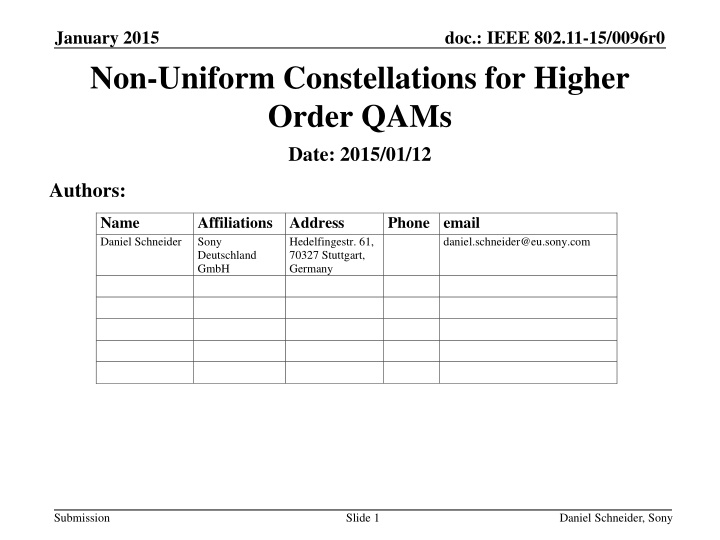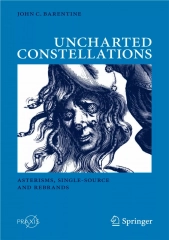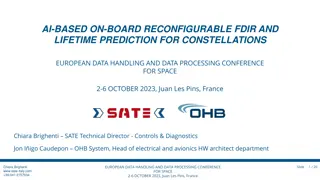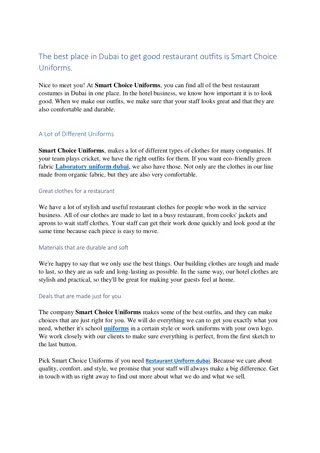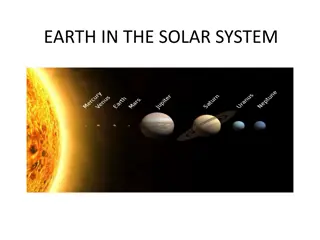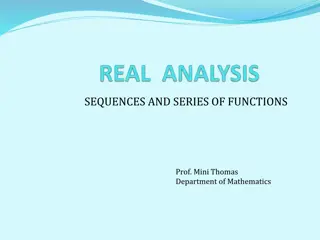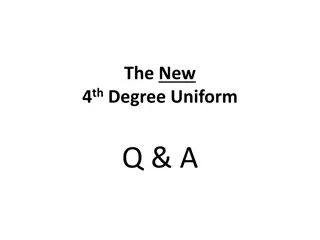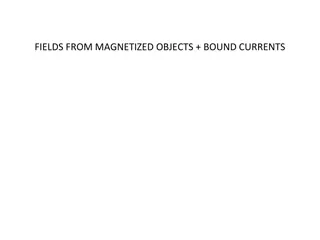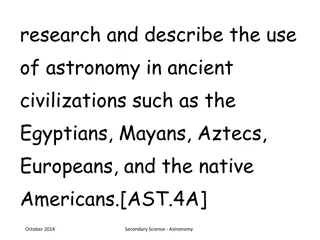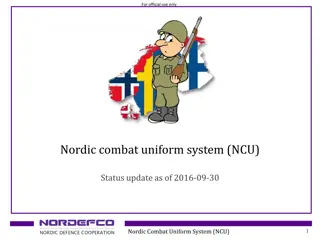Non-Uniform Constellations for Higher Order QAMs in January 2015
Non-uniform constellations (NUCs) offer improved performance compared to uniform constellations (UCs) in the context of higher order QAMs discussed as potential technology for next-generation 60GHz OFDM. The use of NUCs optimizes the location of constellation points, ensuring robust and weak bits carry an optimal amount of information. Two-dimensional NUCs have shown higher gains compared to one-dimensional NUCs, albeit with a requirement for two-dimensional demapping. Examples of NUCs under different SNR conditions illustrate their effectiveness in maximizing channel capacity and information transmission.
Download Presentation

Please find below an Image/Link to download the presentation.
The content on the website is provided AS IS for your information and personal use only. It may not be sold, licensed, or shared on other websites without obtaining consent from the author.If you encounter any issues during the download, it is possible that the publisher has removed the file from their server.
You are allowed to download the files provided on this website for personal or commercial use, subject to the condition that they are used lawfully. All files are the property of their respective owners.
The content on the website is provided AS IS for your information and personal use only. It may not be sold, licensed, or shared on other websites without obtaining consent from the author.
E N D
Presentation Transcript
January 2015 Non-Uniform Constellations for Higher Order QAMs Date: 2015/01/12 doc.: IEEE 802.11-15/0096r0 Authors: Name Daniel Schneider Affiliations Address Sony Deutschland GmbH Phone email Hedelfingestr. 61, 70327 Stuttgart, Germany daniel.schneider@eu.sony.com Submission Slide 1 Daniel Schneider, Sony
January 2015 doc.: IEEE 802.11-15/0096r0 Motivation (1/2) Higher order QAMs discussed in e.g. [1]-[2] as potential technology for next-generation 60GHz OFDM: 128-QAM, 256-QAM (up to 64-QAM in ad) SC: 64-QAM (up to 16-QAM in ad) Non-uniform constellations (NUCs) provide increased performance compared to uniform constellations (UCs) Optimum location of constellation points Robust and weak bits carry optimum amount of information Submission Slide 2 Daniel Schneider, Sony
January 2015 doc.: IEEE 802.11-15/0096r0 Motivation (2/2) Introduced lately in several broadcast standards DVB-NGH [3], DVB/S2x [4] Theoretical shaping gain up to 1.5dB Moderate complexity increase Change of QAM (de)mapper Submission Slide 3 Daniel Schneider, Sony
January 2015 doc.: IEEE 802.11-15/0096r0 NUC: 1-D vs 2D 1D 16NUC for 3dB 1-D NUC: 16-QAM 1-D NUC I/Q symmetry 1-D demapping as for uniform constellations (UC), i.e. same demapping complexity as for regular QAMs 1 0.5 Im{xl} 0 -0.5 -1 -1 -0.5 0 0.5 1 Re{xl} 2-D NUC: 16-QAM 2-D NUC Symmetric quadrants Higher gain compared to 1-D NUC 2-D demapping required Submission Slide 4 Daniel Schneider, Sony
January 2015 doc.: IEEE 802.11-15/0096r0 NUC Example for different SNR Conditions 8NUC for low SNR 8PSK reference 8NUC optimized at 0 dB 1 1 bitwise BICM capacity for AWGN channel 20 bitwise BICM capacity for AWGN channel 8NUC for SNR = 0 dB 2 over-lapping points robust bits robust bits 0.8 0.8 1 0.6 0.6 0.5 100 000 110 010 0.4 Im{xl} 0.4 0 weak bits bit 0 bit 1 bit 2 bit 0 bit 1 bit 2 weak bits 0.2 0.2 -0.5 111 101 001 011 0 0 -10 -5 0 5 10 15 -1 -10 -5 0 5 10 15 20 SNR [dB] SNR [dB] -1 -0.5 0 0.5 1 0.0000+0.4859+0.4859= 0.9719 Re{xl} 0.1282+0.3973+0.3973 = 0.9229 Interpretation: weak bits carry no information, 2 most robust bits with maximum distance 8NUC for high SNR 8PAM reference 8ary hexagonal lattice 1 1 bitwise BICM capacity for AWGN channel bitwise BICM capacity for AWGN channel robust bits robust bits 0.8 8ary ideal hexagonal lattice 0.8 1.5 0.6 110 0.6 1 weak bits 001 0.5 0.4 0.4 000 Im{xl} 100 0 weak bits bit 0 bit 1 bit 2 bit 0 bit 1 bit 2 011 0.2 0.2 -0.5 101 010 0 -1 -10 -5 0 5 10 15 20 0 111 -10 -5 0 5 10 15 20 SNR [dB] -1.5 SNR [dB] 0.9393+0.9697+0.9697 =2.8787 -1 0 1 0.9749+0.9749+0.9779 =2.9276 Re{xl} Submission Slide 5 Eisuke Sakai, Sony Corporation Interpretation: hexagonal lattice = dense packing , maximize minimum Euclidean distance
January 2015 doc.: IEEE 802.11-15/0096r0 Initial Simulations: Parameters Replacement of original uniform constellations by NUC OFDM, MCSs: 18-24 Additionally: 128- and 256-QAM Message Length: 1000bytes Channel AWGN AWGN (channel is very close to AWGN in the LOS case) Gain evaluated compared to UC at FER=10-2 1D and 2D NUC MCS index modulation bit/symbol 18 16-QAM 19 16-QAM 20 16-QAM 21 16-QAM 22 64-QAM 23 64-QAM 24 64-QAM 128-QAM 128-QAM 128-QAM 128-QAM 256-QAM 256-QAM 256-QAM 256-QAM coderate 1/2 5/8 3/4 13/16 5/8 3/4 13/16 1/2 5/8 3/4 13/16 1/2 5/8 3/4 13/16 4 4 4 4 6 6 6 7 7 7 7 8 8 8 8 Submission Slide 6 Daniel Schneider, Sony
January 2015 doc.: IEEE 802.11-15/0096r0 Initial Simulations: Results Channel: AWGN Up to 0.8dB gain of NUC compared to regular QAM gain compared to UC, OFDM AD, AWGN 1.2 1D NUC 2D NUC waterfall SNR gain [dB] @FER=1e-2 1 128-QAM* 256-QAM 802.11ad 0.8 64-QAM 0.6 0.4 16-QAM 0.2 0 1/2 5/8 3/4 13/16 5/8 3/4 13/16 1/2 5/8 3/4 13/16 1/2 5/8 3/4 13/16 code rate Slide 7 * Only 2D-NUC simulated Submission Daniel Schneider, Sony
January 2015 doc.: IEEE 802.11-15/0096r0 Conclusions Significant gain of NUC compared to UC Gain up to 0.8dB for 128-QAM and 0.7dB for 256-QAM Moderate complexity increase Isolated change of QAM mapper and demapper Same demapper complexity as for uniform constellations for 1-D NUCs 2-D demapping required for 2-D NUCs Submission Slide 8 Daniel Schneider, Sony
January 2015 doc.: IEEE 802.11-15/0096r0 References 1. Alecsander Eitan, Qualcomm, 11-14-1378-00-ng60 PHY rate for NG60 2. Alecsander Eitan, Qualcomm et al, 11-14-0652-00- 0wng-wng Next Generation 802.11ad 3. Next Generation broadcasting system to Handheld, physical layer specification (DVB-NGH), DVB BlueBook A160, 2012 4. DVB-S2X BlueBook A83-2 / EN302307-2 Submission Slide 9 Daniel Schneider, Sony
January 2015 doc.: IEEE 802.11-15/0096r0 BACKUP Submission Slide 10 Daniel Schneider, Sony
